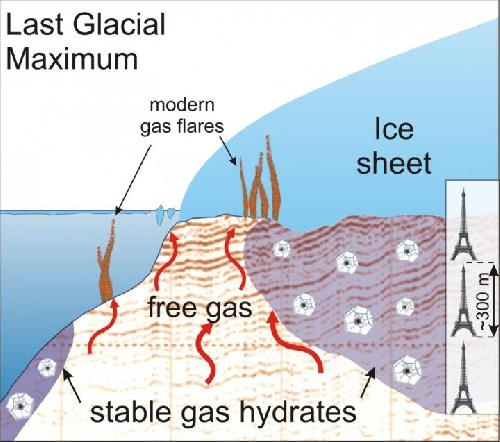One of the major questions today is: What are the ice sheets going to do in an ever-warming climate? Ice sheets of Greenland and Antarctica are major contributors to the sea level rise, which can make life difficult for many coastal nations in the near future.
To understand the ice sheets we need to understand their drainage system - a key component of this is ice streams, fast-flowing rivers of ice, that deliver ice from the centre of the ice sheet to the oceans. Many of these ice streams are speeding up, which may be seen as the logical consequence of the warming climate. But some are slowing down, even stopping, examples of this may be found in the Ross ice streams of West Antarctica.
A new study in Nature Geoscience suggests that a 250km2 sticky spot made up of sediments with gas hydrates in them, slowed down an ice stream in the Barents Sea. This happened sometime during the last ice age, 20 000 years ago, when the Barents Sea was covered with an ice sheet.
 Ice sheets can create, contain and maintain large amounts of gas hydrates, a frozen form of concentrated climate gas methane. The conservative estimate is that Barents Sea Ice sheet contained a 500-meter thick reservoir of gas hydrates. But it may have been over 800 meters thick -- the size of almost three Eiffel Towers stacked on top of each other. Credit: Alexey Portnov/CAGE
Ice sheets can create, contain and maintain large amounts of gas hydrates, a frozen form of concentrated climate gas methane. The conservative estimate is that Barents Sea Ice sheet contained a 500-meter thick reservoir of gas hydrates. But it may have been over 800 meters thick -- the size of almost three Eiffel Towers stacked on top of each other. Credit: Alexey Portnov/CAGE
Slipping on mud
The event left a large footprint on the ocean floor of today. This is the first time that gas hydrates have been inferred to put brakes on an ice stream.
"Many factors influence the flow of the ice, but we know that what happens at the interface between the ice and the ground below is crucial. Our understanding of what is happening under the kilometres of ice remains elusive. " says principal author behind the study Monica Winsborrow.
Ice flows fast because there is lubrication on the bottom. For instance the stream will slide faster on muddy sediments below.
It's like slipping in the mud.
"The friction itself creates heat that melts the base of the ice stream. Also geothermal flow and melt water from the surface reaching the bottom can lubricate the stream. The gravity takes care of the rest." says Winsborrow.
Hook and loop principle
But not all of the bed is equally lubricated. The sticky spots under the ice act almost like hook and loop fasteners. They hook the ice and hold it back until the critical speed and mass is achieved, and the ice stream starts flowing again.
" We know that there are a lot of gas leaks in the Barents Sea today. And we know that there are deeper hydrocarbon reservoirs here. Under the pressure and temperatures of the ice sheet this gas would have created hydrates." Winsborrow states.
The gas hydrates contain methane molecules trapped in a cage of water molecules. To form they absorb water from the sediments. This makes sediments under the ice stiffer and would have strengthened them.
Gas hydrates are also themselves harder, and stiffer than the sediments. The result is that sediments loose their muddiness, making it harder for the ice to slide. The stagnated streams will eventually restart again, as more ice is fed into the stream.
Gas hydrates under modern ice sheets
Gas hydrate sticky spots under ice streams are a potentially widespread feature also today.
"If there are gas hydrates under today's ice sheets, they can slow the ice streams. There are studies indicating that there may be vast reservoirs of hydrates under the West Antarctic Ice sheet. Anywhere you have a hydrocarbon reservoir, water, high pressure and low temperature, you will get gas hydrate." says Winsborrow.
Ice streams of today are extensively monitored with GPS tracking systems, but it is very difficult to gaze beneath three kilometres of ice to see what is going on at the bottom. But scars left by the Barents Sea Ice sheet are visible on the ocean floor today. That makes this ancient ice sheet an important analogue, especially for the modern West Antarctica Ice Sheet, as both are based in marine environments.
"We need these analogies from the past. Understanding what is happening at the base of ice streams is important for modelling and predicting the future of the ice sheets."
source: CAGE - Center for Arctic Gas Hydrate, Climate and Environment